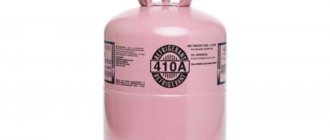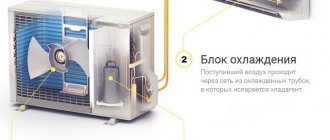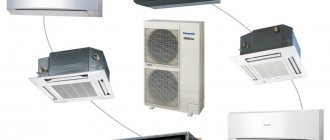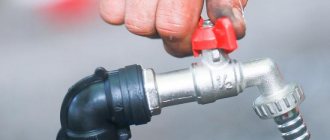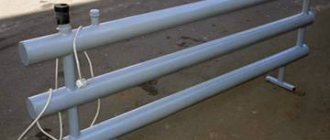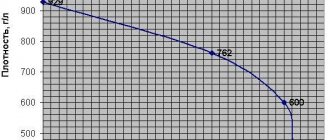- How to find out the amount of refrigerant in the system?
- How much refrigerant is needed for recharging
- How to determine the lack of freon
- How to fill the air conditioner
- Refueling rules
- System diagnostics
Almost all modern split systems, without exception, operate on the basis of refrigerants. Therefore, at a certain period, any owner is faced with the problem of refueling or refilling the system with refrigerant and the question, and how much freon is in the air conditioner at the moment and how much needs to be refilled?
How to find out the amount of refrigerant in the system?
It should be noted initially that the standard name "freon" summarizes all refrigerants known today. And besides, this gas not only possesses the properties of a heat carrier, but also performs a kind of lubrication of the compressor installed in the air conditioner in the outer compartment.
Recall that a standard air conditioning system in any room consists of two compartments that are located outside and inside the room. They are connected by pipelines through which this gas circulates - freon. As a rule, copper pipes of a small cross section are used for this.
The volume of freon in the air conditioner is a value that directly depends on the length of these same copper pipes connecting the two blocks, and on the power of the compressor located inside the block. Based on this data, there is no single value suitable for all devices.
Manufacturers charge systems based on the length of the pipelines. As a rule, its length is not less than 3 meters and more than 5 meters. Basically, the manufacturer charges about 15 grams of refrigerant per 1 meter of track. Do not forget that the power indicator also has an effect, therefore the approximate content of freon in powerful air conditioners is about 0.6 kg, and in less powerful about 0.09 kg.
Of course, during the operation of the device, any refrigerant can gradually evaporate. This is sometimes faster because copper piping can be damaged and leaks occur. Sometimes the rapid evaporation of freon is also affected by poor-quality compounds, which also lead to leakage. In such cases, refueling or refueling of the device will be carried out only after complete evacuation of the entire system.
Precautions when working with freon
If you are going to fill the air conditioner with your own hands - remember:
- Chlorine brands are harmful to the body. Avoid contact with mucous membranes (eyes, mouth), and do not inhale them.
- With a high concentration of freon, you can get poisoned. Therefore, do not work indoors - be sure to open the window and door, if available - turn on the hood (in the kitchen and in the bathroom).
- If liquid freon gets on the skin, you can get frostbite. Therefore, you only need to work with rubber gloves and closed clothing (not a T-shirt or a T-shirt with shorts).
If during operation the refrigerant gets on the skin or mucous membranes, it must be immediately washed off with water, and the place must be lubricated with petroleum jelly.
If you experience symptoms of suffocation, or any other abnormal signs, you must immediately stop work, leave the room and ventilate it.
Why can the air conditioner gurgle, how is it dangerous and what to do?
Why do you need a screen for an air conditioner, and how to make it yourself?
Similar posts
How to determine the lack of freon
Of course, before dealing with the issues of refueling, each owner does not hurt to know how to determine the fact that there is not enough refrigerant in the device and either its complete replacement or refueling is required.The following factors indicate the lack of freon:
- the split system has become much less efficient in dealing with indoor air cooling;
- the air conditioner has stopped cooling the air at all;
- ice or frost appeared in the places where copper pipes were connected on the outdoor unit, resembling a "fur coat" in old Soviet refrigerators.
Before refueling, one should also take into account the fact that it is necessary to determine the pressure on the cooling split system from the type of freon charged into it. There are several brands of this refrigerant available today.
For example, if 22 freon is charged into the air conditioner, and the street temperature varies between 25-30 degrees, then the pressure should correspond to an indicator of 4.5 bar. If the temperature is below 15 degrees, then the pressure will be 3.5 bar.
If freon 420 is charged into the split system, then at a temperature range of 25 to 30 degrees, the pressure indicator will be 6.5 bar. And at 15 degree temperature readings, the pressure will be 5 bar.
Specialists who service air conditioners know all the nuances and subtleties, but if you decide to independently determine the amount of refrigerant and refuel, then these nuances should be taken into account.
How often and when should the air conditioner be refilled?
You need to fill the air conditioner in such cases:
- After installing or reinstalling to a new location.
- After repair, if freon lines were turned off in the process.
- If there is a leak from the circuit. It is almost always necessary to refuel the air conditioner due to a leak.
- Every 2 years (the frequency is approximate, if the system is mounted correctly, then it can be less often). On average, for 1 year of operation, about 8% of the volume of freon is lost.
To understand that the time has come for a replacement is possible by the quality of the device.
Signs of a leak are as follows:
- frost appears on the outdoor unit;
- the room is being cooled (or heated) more slowly than before (at about the same outside temperature); at the same time the air conditioner works longer (or without interruptions at all), and it has to be loaded more;
- the inverter model can often turn off and show a malfunction code;
- when the air conditioner is operating, an unpleasant odor appears (not dust).
Checking the freon pressure in the air conditioner (video)
How to fill the air conditioner
In fact, you can do the refueling process yourself.
- Weigh the refrigerant bottle.
- Further, by opening the valve, you can allow the gas to move freely into the air conditioner pipeline.
- The valve is closed when the required amount of freon leaves the cylinder.
Experts recommend not refueling, but refueling the system with gas. To do this, the freon remaining in the system is released outside using a special fitting, and using the scales, the cooling system is refueled and filled with exactly the amount indicated on the metal table by the manufacturer. This option will be more efficient and simpler.
According to the advice of the same experts, it is better not to refuel the air conditioner system a little than to pump excess freon into it. The fact is that an excessive amount will prevent the refrigerant from passing from a liquid to a gaseous state, it simply will not have time to transform.
A more complex refueling process is refueling the required amount with reference to the temperature. In this case, a thermometer is brought to the fan, which should show a value corresponding to the indicator in the passport.
If the temperature is in the range of 5-8 degrees, then this indicates that there is a sufficiently powerful compressor in the unit. The device itself is operating normally and there is sufficient refrigerant in the system to operate efficiently.
But this action is absolutely inapplicable to an inverter device.In it, the compressor directly depends on the thermal loads that it experiences, therefore, its power constantly has a different value.
Filling the air conditioner with freon by weight
Each air conditioner is charged at the factory with a certain amount of refrigerant, the mass of which is indicated in the documentation for the air conditioner (also indicated on the nameplate), there is also information about the amount of freon that must be added additionally for each meter of the freon route (usually 5-15 gr.)
When refueling using this method, it is necessary to completely release the refrigeration circuit from the remaining freon (into a cylinder or vent into the atmosphere, this does not harm the environment at all - read about this in the article on the effect of freon on the climate) and evacuate. Then fill the system with the specified amount of refrigerant by weight or using the filling cylinder.

The advantages of this method are high accuracy and sufficient simplicity of the process of filling the air conditioner. The disadvantages include the need to evacuate freon and evacuate the circuit, and the filling cylinder, moreover, has a limited volume of 2 or 4 kilograms and large dimensions, which allows it to be used mainly in stationary conditions.
Refueling rules
In order to refuel on your own and without prejudice to the device, you must adhere to certain rules.
- One of the easiest and safest ways to refuel is by using weight. All the necessary information is indicated on a plate attached to the body of the device. New outdoor units do not need refueling if the piping length is not more than that specified by the manufacturer.
- Split - systems that have been in operation for a long time and have been dismantled need to be refilled only by 10% of the total mass of the refrigerant. This information is again indicated on the nameplate.
- Sometimes, if the installation or piping is incorrect, the amount of refrigerant in the unit may be low. And in order to correct the situation, you need to release all the freon in the device outward, trying to keep the oil inside the compressor. For this, the valve through which the filling takes place is slightly opened. Within a few hours, all the freon will be released from the system. If the oil starts to flow out with the gas, then you need to open the valve even less. When all the refrigerant comes out, you can refuel with new freon.
System diagnostics
After you calculate how much freon is required to refuel the split system and fill the required amount, it is advisable to check the device for leaks and check the compressor.
As mentioned above, it is undesirable to perform brute force with the amount of freon. If the amount of refrigerant exceeds the norm by 10%, then this will not lead, of course, to wear on the compressor, but will cause malfunctions in its operation. If you notice that the compressor is not working efficiently, you can try to refuel about 10% of the freon, while the system itself should work properly. If its performance has not improved after refueling, then most likely it is not a lack of refrigerant. Perhaps there was some kind of breakdown inside.
If you decide to charge the system yourself, pay attention to the type of refrigerant used in it. Currently, the devices use a completely safe gas, which not only excludes the possibility of an explosion, but also does not harm the environment when it enters the atmosphere.
The first models of air conditioners came with the use of R-22 freon. But it was found that it destroys the ozone layer of the earth and works ineffectively at low temperatures, so manufacturers abandoned its use and switched to more modern and completely safe refrigerants.
Thus, you can calculate the required amount of freon, refuel the system and buy the necessary refrigerant completely on your own.
Equipment for filling air conditioners
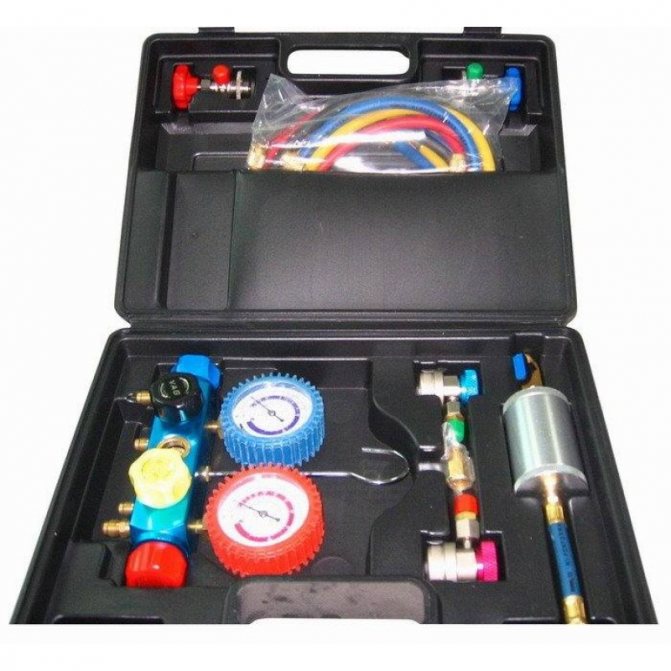

Air Conditioner Refueling Tool Kit
A set of equipment for refueling air conditioners allows you to save on payment for the services of a service representative and do the work yourself. The manual station allows diagnostics of the split system and filling the circuit with refrigerant. Automatic and semi-automatic car air conditioner refueling machines are expensive and are used commercially. Household and semi-industrial climate systems are serviced using a standard portable kit. It includes:
- gauge manifold;
- Vacuum pump;
- filling hoses;
- adapters and adapters for R410 freon;
- ball valve;
- electronic balance.
The kit fits into a handy case; an instruction manual is attached to work with it.
